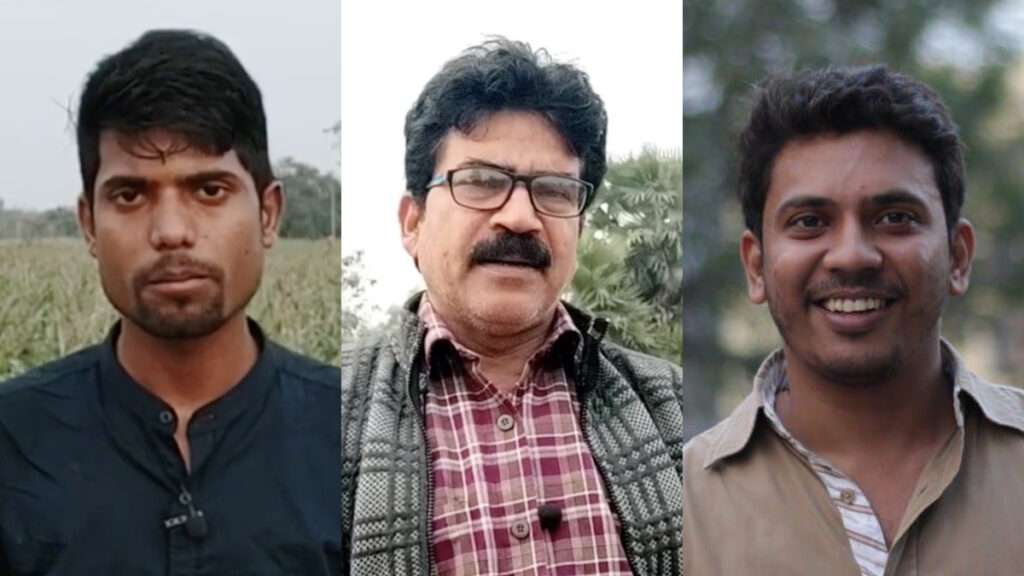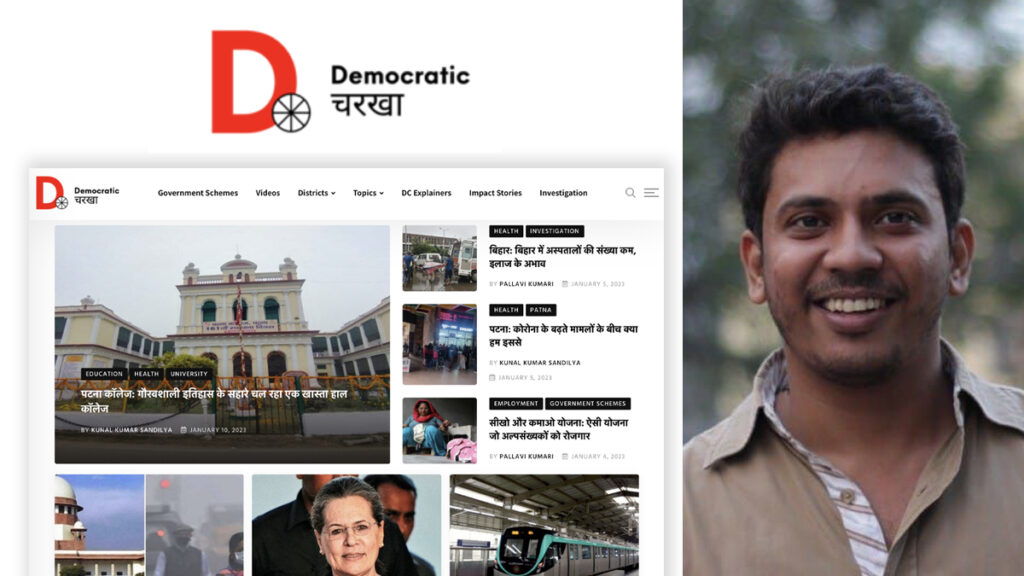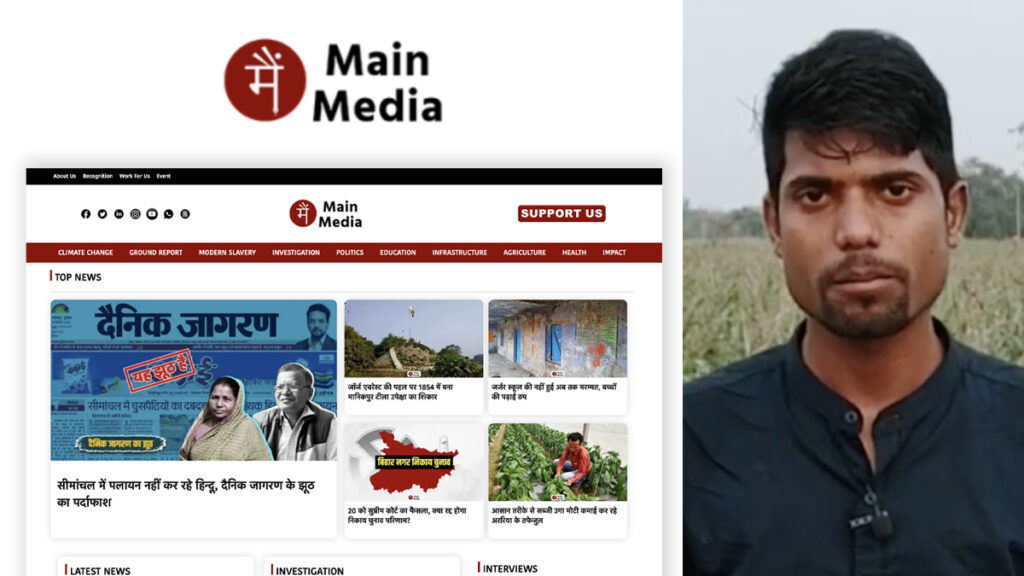
When the staff at Gannett newspapers in the US coined the term MOJO (Mobile Journalism) to describe new ways of gathering and distributing news using emerging technologies in 2005, they would not have imagined its virality and use ten years later.
Ask new media journalists and our Community Correspondents Shah Faisal, Avijit Adhikary and Amir Abbas about the antecedents of the term, and they are blank as an antiquated classroom blackboard. But, give them a phone camera and a topic to gather news or a feature story from, and you’ll be sure to get a good quality production involving all the required shots, angles, interviews, a piece to camera and an impactful script to round up the package.
But what makes these three Community Correspondents unique is that they are using the MOJO skills they learned at Video Volunteers to work for community betterment, at the same time as being journalists for profit-making mainstream and digital journalism publications.
Mobile journalism allows them to use the latest technology to report stories that are often overlooked by mainstream media, and reach audiences that are often left out of the traditional news cycle.
MOJO has given them the tools to bring attention to the issues faced by marginalized communities and give a voice to the voiceless.
The three Amigos
Amir is a young media entrepreneur who runs his own web news portal, ‘Democratic Charkha’, which focuses on hyperlocal news and incidents in Patna, the capital city of Bihar. Faisal is the deputy editor of ‘Main Media’, a vernacular news website in Bihar, and Adhikary is a correspondent at Anando Bazaar Patrika, one of the oldest Bengali newspapers in India that is published in West Bengal’s capital city Kolkata.
So, what does it take for these journalists to straddle their careers on different boats with different speeds, that are motored by different engines, and have different destinations with different passengers? (or, in this analogy, different types of audiences?)
For Amir Abbas, working with mainstream media involves the role of many people, and it can be hierarchical. “The issues covered are wide-ranging, the reach is across the state and readership cuts across age groups, but the impact is limited and sometimes non-existent. As a community journalist, I have felt closer to the person involved and the issue they face. This accelerates my drive to tell their story and bring it to the concerned officials to ensure they get the justice they deserve.”
After his three failed attempts at starting a YouTube news channel, in 2020 Aamir founded his own media venture the Democratic Charkha, along with two other Patna University students.
It's a mixed-medium platform that features written articles and video stories. The platform aims to bring attention to under-reported issues and give a voice to marginalized communities, just like Amir's experience with VV.
The platform was started with a grant from Independent and Public Spirited Media (IPSM), a Bengaluru-based foundation that promotes and funds excellence in independent, public-spirited, and socially impactful journalism,
We started our journey by covering Patna but till today we are in Begusarai, Samastipur, Siwan, Katihar, Saharsa, Supaul, Sitamarhi, Aurangabad, Sheikhpura and Araria. Till date we have made a direct impact in more than 100K lives.
At present, the Democratic Charkha website attracts a monthly traffic of 1,50,000 viewers and readers and their Youtube channel registered 1,00,000 views per month.
“I have a team of 10 members and 15 stringers across Bihar,” Abbas said.
Youtuber Shah Faisal likes to do community stories where he likes to report on daily news breaks and put a spotlight on crucial issues where the masses are involved and impacted.
“That’s why I took up the offer from ‘Main Media’ in 2019, even while I was a Community Correspondent for VV. I wanted to cover every bit of important news for my region (Seemanchal) on their Youtube channel, just like the way mainstream media does it on television. The mainstream media ignores several ‘small’ developments because it may not be important to the rest of the nation. In sharp contrast, VV’s style of storytelling may just involve one person’s long-standing issue that we try to lead to an end resolution, which may have a larger impact on other community members at times.”
Since 2022, he has been focusing on a programme called ‘Jago Bihar’ (wake up Bihar) in which his focus is to do stories on public welfare and development schemes announced by the BIhar Government.
While Journalism veteran Avijit Adhikary still considers mainstream media as his main course meal, he likes the crunchy impact that community media reporting provides to his news-oriented tastebuds.
“With mainline media, I cover daily news reports. There is no scope for achieving impact. Your report on the day's news highlights an issue, and that's it. Whereas, with VV, there is a scope for achieving an impact by resolving a matter. I create a video report, take it all the way to the authorities and try to bring a positive end to the matter that should benefit the person involved. Community media takes me closer to the community, gives me happiness that I can empower people, and in return, I get a lot of love and respect”.
News reporting for mainstream

In the six years he's been with VV, Amir says he noticed that despite the impactful, grassroots-level journalism that they do, some gaps needed to be addressed.
"I felt the need to do stories faster and wanted a wider reach of audience, and the only way to do that was start my own media organization", says Aamir Abbas. According to him, while VV does angle-based stories, they did not do much of mainstream or regional political coverage. He feels the need to cover that gap and through his platform, Democratic Charkha, he manages to do 50% articles that are like spot news and covering various issues and 50 % are videos.
"On DC, we've opened the platform for the common man to write articles on issues that are troubling them or the community they belong to so that their voice comes out unfiltered," the community media's young CEO says.
Shah Faisal’s inherent restless-calm attitude led him to accept the position offered by ‘Main Media’ to head their bureaus in three states in one go.
“The high-quality training I received at VV in 2018 gave me the insight and courage to handle a wide range of stories in my region. I’ve reported on various wide and nuanced issues caused by the regular and seasonal floods in my region, probe into issues of crop-related compensation of farmers and labourers and even do hidden camera stories when required”, says the soft-spoken anchor.
Shah Faisal adds that the power of mainstream media is that authorities who ignore the common man’s problems fear that the camera will expose their easy-going approach before everybody and especially their seniors, helping him make headway in a sidelined matter.
His two-decade stint with mainline media helps open doors for Avijit Adhikari that are usually rusted and stubborn. “When I go to meet officials to show them video stories shot for VV, they agree to meet with me as they had already heard about Ananda Bazar Patrika and fear that they will be in trouble. Being
with an established media house for years gives me the edge to power my way through corridors that are otherwise considered inaccessible. Also, my access to the press club gives me information that I would not be able to get only as a Community Correspondent and this is a crucial difference,” says the stalwart scribe.

How does the commercials stack up
While filing 2-3 stories a month, a journalist can make up to INR 12,000 per month.
According to Amir he used to earn INR 5,000 per month when he started reporting for VV. “In recent years, the pay structure has improved. Now, CCs can earn up to INR 12,000 by filing 3 stories.”
Amir now makes upwards of INR 50,000/month as a CEO, however, his work hours have now stretched to almost 12 -14 hours everyday.
Avijit is in charge of tracking local news for the Bishnupur sub-division for Anada Bazar Patrika. He files on an average 3-4 long-form articles per month along with stories on daily political, civil and other issues. He earns a meagre INR 50 for small copy and INR 200 for long copy.
“I work for about 15 days at Main Media and earn about Rs 20,000 per month. I shifted my focus to highlight the pros and cons of various public welfare schemes announced by the government and if people are getting anything from them,” Shah Faisal adds.
How they found their MOJO
Amir Abbas wrote social media content for a popular youth organization-Youth Ki Awaaz and was a theatre actor before he was introduced to Video Volunteers in New Delhi in 2015.
"It was at VV that I got a medium to voice concerns about local issues and experienced how strong media pressure can be on any administration. The word ‘interview’ opens doors," says the tech-savy community journalist.
Once he was trained in video journalism, Amir trained his camera on areas and issues which most media houses and newspapers didn't consider 'newsy'. With his penchant for writing, he wrote scripts to highlight the plight of the homeless people who were not getting their dues in government shelters. He did video stories about the state of affairs at his alma matter Patna University including one when students found the going tough because the library was shut for two years.
At Patna University the library has been shut for Two Years – Video Volunteers
Amir's story on the NRC issue, that is about citizenship in India, has Muslim men swearing their allegiance to India on camera and willing to die for the country rather than being labelled as Bangladeshi refugees.
Poor fearful of being termed ‘Stateless’ – NRC – Video Volunteers
Describing VV in three words, Amir says, it would be "Empowerment, Capacity to think, Platform to act".
Shah Faisal did his first mobile journalism story for a local youtube new network called ‘Khabar Seemanchal’ (News Seemanchal) on a borrowed phone. “I have an inherent trait to work for people’s issues, script and anchor my own videos. In 2017, there was a malaria outbreak due to floods. I visited a village where there were many malaria cases, and this story post got the attention of local politicians who got medical aid to the people. This also won the local people’s trust in me, and they started tipping me off when issues emerged”, he says.
Keeping his ear firmly on the ground, Shah Faisal got to know about a village in his locality where there was a sudden outbreak of skin disease and gallstone problems. His story revealed the high-level content of iron content in the water.
A year later and with many stories under his belt, his efforts led him to get a spot in the VV community media team.
“Even though I had done quite a few MOJO stories by then, I was blown away by the quality training that the VV team provided. It was specifically gratifying to meet correspondents like Shikha Pahadin and see her stories, learn from her personally and work under the mentorship of Mithilesh ji. I could not have asked for anything better,” he says with pride.
Faisal, like most VV Correspondents, was quite active during the COVID phase. He organized vaccination camps, dispelled rumours about the vaccine and reported about the poor state of quarantine centres in his locality.
Horrid Condition of Quarantine Centre in Bihar – Video Volunteers
The ‘pen is mightier than the sword’ was Avijit Adhikary’s method of approach to journalism since he began his career with a Bengali print newspaper like Anando Bazaar Patrika. But with the introduction of mobile journalism into his life, he quickly realized the might of the camera could go beyond the power of the pen and the sword.
“Before joining VV, I was helping a CC, and was taking him to communities where he could not access earlier. While helping him, I realized that even I could do this job. It was not very challenging for me to pick up mobile journalism, and now I enjoy it because it helps me work closer with issues that go beyond the newspaper readers' domain," says the Bengal-based journalist
And a difference he did make with his impactful story about the troubles people faced due to a fallen bridge; that led to the rebuilding of the bridge.
In another instance, Avijit's community journalism has compelled authorities to act and provide villagers with their basic needs, like electricity.
"I can actually make a difference in the life of people affected by various issues,” says Avijit Adhikary with conscious recognition of the powers he holds with both the pen and the lens.
MOJO has become a vital tool for community journalists like Shah Faisal, Avijit Adhikary, and Amir Abbas. Despite not being aware of the origins of the term, they have fully embraced the MOJO style of news gathering and are able to produce high-quality stories using just a phone camera. Their unique approach is that they continue to report for mainstream news organizations in a traditional manner as well, allowing them to reach a wider audience and use the power of both traditional and new media platforms to bring attention to important issues and stories that matter to their communities.
By utilizing MOJO, these journalists are able to use the latest technology to bring important stories to a wider audience and create a positive impact on their communities.
Better Texas Wagering m pana365 login Websites an internet-based Sportsbooks in the 2024
A great statewide cellular system might possibly be a necessity to own revenue achievement in a state as the huge since the Tx, but officials may be politically reluctant to make it betting beyond a good select few parts. Closest to some of Tx’ most west metropolitan areas such Amarillo,...
Best Brokerage Accounts for Trading: 2024 Finest Selections
Another way away from thinking about one, but not, is that a broker account resting laden with uninvested bucks isn’t vulnerable to and make hardly any money sometimes. You need to use tips for example advantage allotment and you can variation to reduce the possibility of you losing profits, but...
